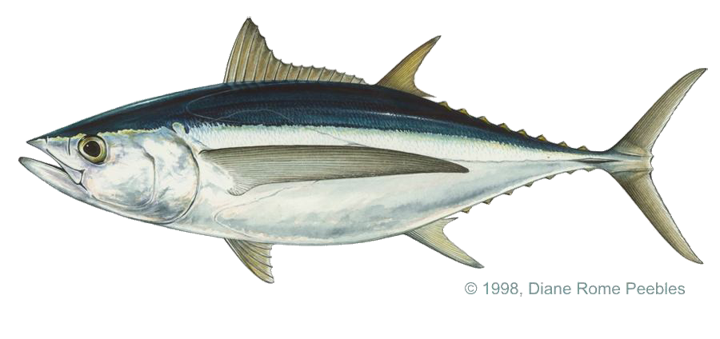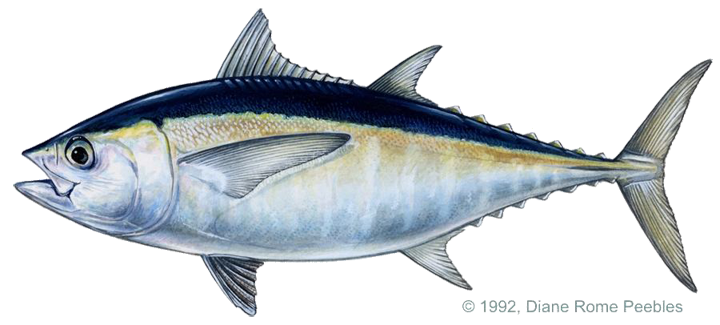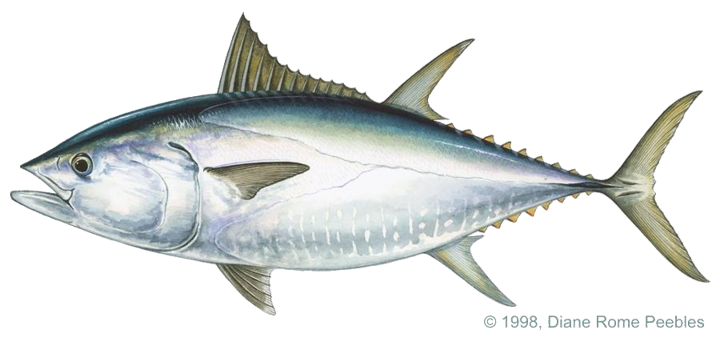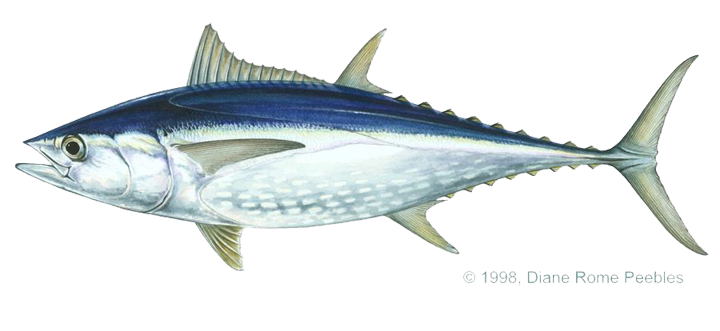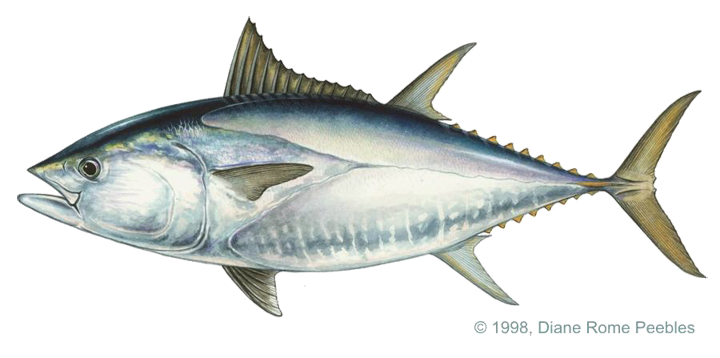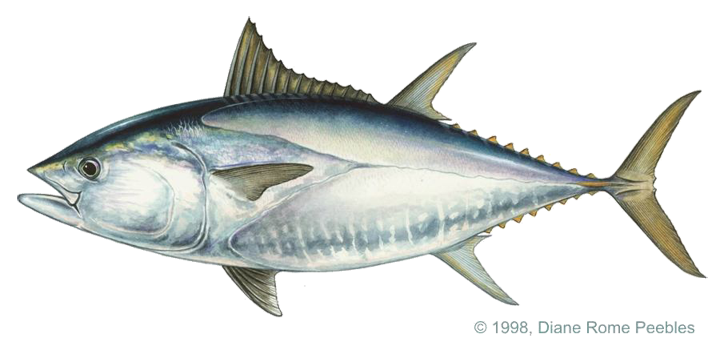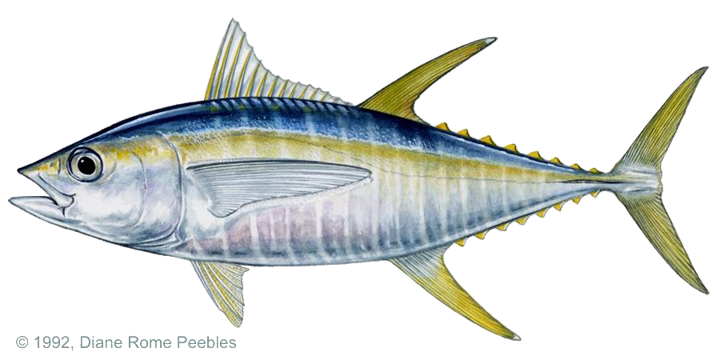Game Fish Identification Reference Guides
Tuna, bigeye (Atlantic)
(Thunnus obesus)
(Thunnus obesus)
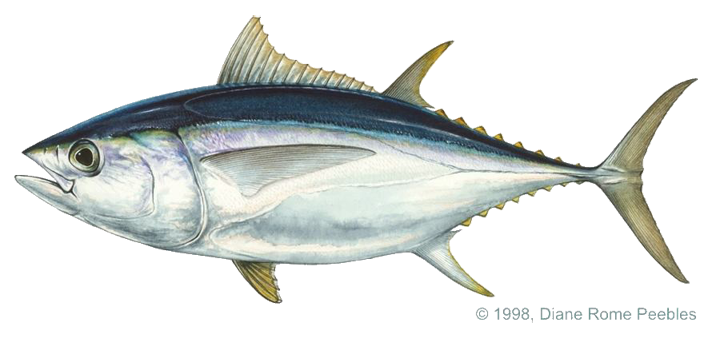
(Lowe, 1836); SCOMBRIDAE FAMILY
Found in warm temperate waters of the Atlantic, Pacific and Indian Oceans, this schooling, pelagic, seasonally migratory species is suspected of making rather extensive migrations. Schools bigeye tuna generally run deep during the day. Schools of bluefin, yellowfin and some others are known to occasionally swim at the surface, especially in warm water.
The pectoral fins may reach to the second dorsal fin. The second dorsal and anal fins never reach back as far as those of large yellowfin tuna (Thunnus albacares). It has a total of 23 31 gill rakers on the first arch. The margin of the liver is striated. The two dorsal fins are close set, the first having 13 14 spines and the second, 14 16 rays. The anal fin has 11 15 rays. On either side of the caudal peduncle there is a strong lateral keel between two small keels that are located slightly farther back on the tail. The scales are small except on the anterior corselet. The vent is oval or teardrop shaped, not round as in the albacore. The first dorsal fin is deep yellow. The second dorsal fin and the anal fin are blackish brown or yellow and may be edged with black. The finlets are bright yellow with narrow black edges. The tail does not have a white trailing edge like that of the albacore. Generally, there are no special markings on the body, but some specimens may have vertical rows of whitish spots on the venter.
At one time it was not recognized as a separate species but considered a variation of the yellowfin tuna. They are similar in many respects, but the bigeye's second dorsal and anal fins never grow as long as those of the yellowfin. In the bigeye tuna the margin of the liver is striated and the right lobe is about the same size as the left lobe, in the yellowfin tuna the liver is smooth and the right lobe is clearly longer than either the left or the middle lobe.
Its diet includes squid, crustaceans, mullet, sardines, small mackerels and some deep water species. Fishing methods are trolling deep with squid, mullet or other small baits, or artificial lures and live bait fishing in deep waters with similar baits. It is an excellent food or sport fish, an important commercial species
Found in warm temperate waters of the Atlantic, Pacific and Indian Oceans, this schooling, pelagic, seasonally migratory species is suspected of making rather extensive migrations. Schools bigeye tuna generally run deep during the day. Schools of bluefin, yellowfin and some others are known to occasionally swim at the surface, especially in warm water.
The pectoral fins may reach to the second dorsal fin. The second dorsal and anal fins never reach back as far as those of large yellowfin tuna (Thunnus albacares). It has a total of 23 31 gill rakers on the first arch. The margin of the liver is striated. The two dorsal fins are close set, the first having 13 14 spines and the second, 14 16 rays. The anal fin has 11 15 rays. On either side of the caudal peduncle there is a strong lateral keel between two small keels that are located slightly farther back on the tail. The scales are small except on the anterior corselet. The vent is oval or teardrop shaped, not round as in the albacore. The first dorsal fin is deep yellow. The second dorsal fin and the anal fin are blackish brown or yellow and may be edged with black. The finlets are bright yellow with narrow black edges. The tail does not have a white trailing edge like that of the albacore. Generally, there are no special markings on the body, but some specimens may have vertical rows of whitish spots on the venter.
At one time it was not recognized as a separate species but considered a variation of the yellowfin tuna. They are similar in many respects, but the bigeye's second dorsal and anal fins never grow as long as those of the yellowfin. In the bigeye tuna the margin of the liver is striated and the right lobe is about the same size as the left lobe, in the yellowfin tuna the liver is smooth and the right lobe is clearly longer than either the left or the middle lobe.
Its diet includes squid, crustaceans, mullet, sardines, small mackerels and some deep water species. Fishing methods are trolling deep with squid, mullet or other small baits, or artificial lures and live bait fishing in deep waters with similar baits. It is an excellent food or sport fish, an important commercial species













